
Poston, Arizona
(click on picture to enlarge)
 Map of the camp |

Kabuki theater at Poston Camp 1. |
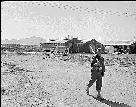
Military sentry keeping civilians away from mess hall at Poston 1., 05/10/1942 |
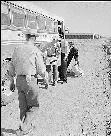
Unloading baggage belonging to evacuee of Japanese ancestry. Caucasian construction employees assist evacuee in getting their belongings from the bus at the relocation center. |
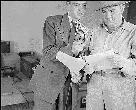 Announcer Chet Huntley of the C.B.S. interviewing Ellis Georgia, War Relocation Authority Area engineer, in a nationwide hookup. |

Mrs. Lyle Kurisak, evacuee of Japanese ancestry, Norris James, War Relocation Authority official, in an interview at this War Relocation Authority center during a CBS nationwide hookup. |

Evacuees of Japanese ancestry are given a preliminary medical examination upon arrival at this War Relocation Authority center. |
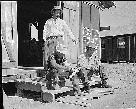
Members of the police department carving clubs at this War Relocation Authority center for evacuees of Japanese ancestry. |
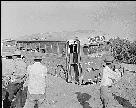
This bus, bringing evacuees of Japanese ancestry to the Colorado River Relocation center has become sand bound near its destination. |
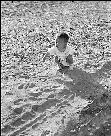
Little evacuee playing in the desert sand at this War Relocation Authority center for evacuees of Japanese ancestry. |
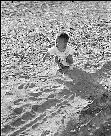
Little evacuee playing in the desert sand at this War Relocation Authority center for evacuees of Japanese ancestry. |
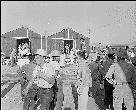
Site Number 1 Arrival of evacuees of Japanese ancestry at this War Relocation Authority center. |

Filling straw ticks for mattresses at Colorado River Relocation center for evacuees of Japanese ancestry. |
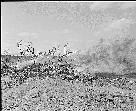
Site # 3. Burning brush to clear more land for the enlarging of this relocation center for evacuees of Japanese ancestry. |
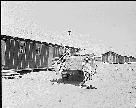
Apache Indians are assisting in the unloading of beds for evacuees of Japanese ancestry at this War Relocation Authority center which is located on the Colorado River Indian Reservation. |
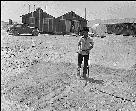
Jim Morikawa sprinkling in an attempt to settle the dust at this War Relocation Authority center for evacuees of Japanese ancestry. |

Evacuees are brought in by car and truck from the train to this War Relocation Authority center. |
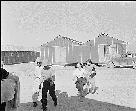
Evacuees of Japanese ancestry spending their first day at this War Relocation Authority center |

Evacuees of Japanese ancestry are being registered upon first arrival at this War Relocation Authority center. |
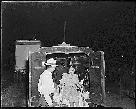
Arrival of young evacuee cripple of Japanese ancestry by ambulance to this War Relocation Authority center. A doctor is in attendance. |
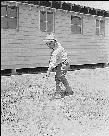
Evacuee of Japanese ancestry at this War Relocation Authority center cleaning up the grounds around the Administration building. |
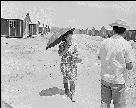
This evacuee is fortified with an umbrella for protection from the sun, and high- top boots for strolling through the dusty streets at this War Relocation Authority center |
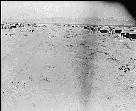
Street scene at the relocation center for evacuees of Japanese ancestry. This is seventh street facing west. |
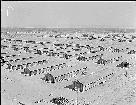
Living quarters of evacuees of Japanese ancestry at this War Relocation Authority center as seen from the top of water tower facing south west. |
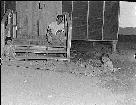
Mosaru Oshio with his children on the steps of his barrack home at this War Relocation Authority center for evacuees of Japanese ancestry. |
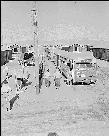
Arrival of Japanese Americans, evacuated from west coast defense areas at this War Relocation Authority center. |

Evacuees of Japanese ancestry register upon arrival at War Relocation Authority centers where they will spend the duration. |

Baggage is inspected for contraband upon arrival at War Relocation Authority centers where evacuees of Japanese ancestry are spending the duration |

Typical shower facilities at this War Relocation authority center for evacuees of Japanese ancestry. |

Young mother of Japanese ancestry arrives with her young baby at this War Relocation Authority center. |

Site Number 1, Camp Number 1, facing Southeast., 04/24/1942 |
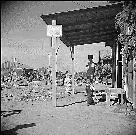
A scene in block 19, which is ingeniously landscaped by evacuee residents., 12/31/1942 |
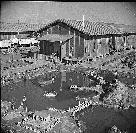
Landscaping done by evacuee residents of Camp Number 1., 12/31/1942 |
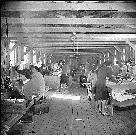
Sewing school, 01/04/1943 |
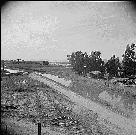
In the foreground can be seen the irrigation canal which will supply Poston with agricultural water. This canal receives its water from the Parker Dam. In the background can be seen the Colorado River. |
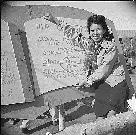
New Years Fair. Pretty Nami Nadaoka is shown with the program sign at the fair, which was held at Camp Number 2. |
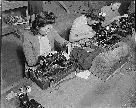
Sewing School. Evacuee students are taught here not only to design but make clothing as well |

Evacuees of Japanese ancestry are signing up for the War Relocation Authority Work Corps. |

Arrival of Japanese Americans, evacuated from west coast defense areas at this War Relocation Authority center. |

Evacuees of Japanese ancestry register upon arrival at War Relocation Authority centers where they will spend the duration. |

Site Number 1, Camp Number 1, facing Southeast., 04/24/1942 |
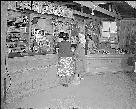
Dry Goods canteen, Camp Number 1, 01/04/1943 |
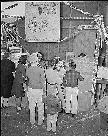
New Year's Fair. Pop corn stand run by girl scouts., 01/02/1943 |
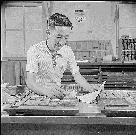
Saburo Tomita, foreman of the print shop, and the only Japanese-American to hold a card in the Pressman's Union. Saburo formerly worked for the Morrisey Brothers Printing Company in Los Angeles, and has had 22 years experience as a pressman. |

Slight damage done by fire believed [to be] incendiary at the apartment occupied by Charles Smith, member of the administration staff in Building 14, Block 34, at this center. On the same night two other fires of similar nature were discovered in adjoining barracks buildings. |

Corner of Barrack G in Block 34, where appointed personnel live at this relocation center, which was damaged by fire believed of incendiary origin. Building shown in background is the apartment occupied by Charles Smith, which was also damaged slightly by a similar fire discovered less than an hour earlier on the same evening. |

Damage done to Barracks G, Block 34, occupied by administrative personnel by a fire believed [to be] incendiary. Another fire was also discovered at the opposite end of this same building later the same evening |

Damage done by fire believed of incendiary origin to the Barracks G, Block 34 building, occupied by administrative personnel at this War Relocation Authority center. William Hoffman, War Relocation Authority Fire Protection Officer, is shown inspecting the damage and pointed to the burned wood. Another fire was discovered at the other end of this building and one also at an adjacent apartment. |

Remains of box of trash which was pulled away from Barracks G, Block 34, occupied by administrative personnel, when fire believed of incendiary origin was discovered. Partly burned box had been filled with shredded paper and lighted. Damage to the building was slight. |
 William Hoffman, Chief of the Fire Protection Section of War Relocation Authority pointing to burned place on building and to match which was dropped on the ground below. This was one of three fires discovered in less than an hour's time in the administrative staff living quarters at this War Relocation Authority center. |

William Hoffman, Chief of the Fire Protection Section of War Relocation Authority to burned tar paper on the side of Barracks G, Block 34, where a fire believed of incendiary origin had been discovered. This was one of three such fires discovered in less than an hour in the quarters occupied by appointed personnel at this War Relocation Authority center. |
 Overall Community Council of the three units. Japanese garden in background next to Administration building, which is being completed by the evacuees. |
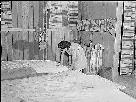 Mrs. Iwasaki tidies up her home at this War Relocation Authority center. Her family was the first family to be admitted to this center where evacuees are now spending the duration. |
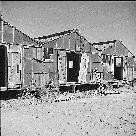
Some of the "blocks" which were vacated earlier, are already dropping to pieces as shown here. The barracks were of cheap construction, rough lumber, and tar paper and few people thought that they would be occupied for three years. Units II and III of the Colorado River Relocation center, Poston, Arizona, meet their scheduled closings ahead of the deadline. These two camps which at one time had a combined population of more than 8,500 Japanese Americans are now completely deserted. |
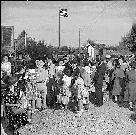
Evacuees stand in line before the departure station where they are to receive their ration books and bus tickets. After the final plans have been made, boxes packed, and grants picked up, the residents of Poston are at last ready to leave the center. Now that so many of their friends have gone out before them, it is with a feeling of anticipation rather than one of sorrow that the evacuees prepare to leave place which for three years has been home to them. |

Memorial |
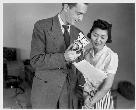 Florence Mori, evacuee of Japanese ancestry at this War Relocation Authority center, taking part in this CBS broadcast. Chet Huntley of the CBS is directing the program. 5/26/42
|
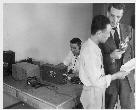 Kay Nishimura, evacuee of Japanese ancestry, and Chet Huntley (right), CBS announcer, in an interview at this War Relocation Authority center during a nationwide hookup. 5/26/42
Memorial |
 Evacuees of Japanese ancestry are given a preliminary medical examination upon arrival at this War Relocation camp. 5/10/42
|
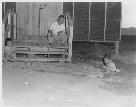 Mosaru Oshio with his children on the steps of his barrack home at this War Relocation Authority center for evacuees of Japanese ancestry.
Memorial |
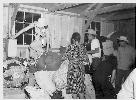 Evacuees of Japanese ancestry are locating their baggage upon arrival at this War Relocation Authority center. 5/17/42
|
 Organizing first office force consisting of evacuee girls. 5/10/42
Memorial |
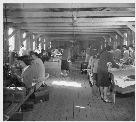 Sewing school. 1/4/43
|
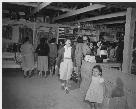 Dry goods canteen, camp 1. 1/4/43
Memorial |
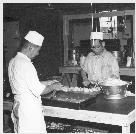 Cooks and chefs among the evacuees of Japanese ancestry were immediately given opportunity to follow their callings after they arrived at the relocation center on the Colorado River Indian Reservation. Kitchen scene..
|
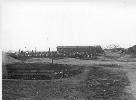 Fire which started in the barrack, remains of which are shown in the foreground, swept six barracks in Poston II, block 202, Christmas night, 1943. Only efficient work of the evacuee fire department from all three units saved the barracks shown in the background. High wind made control of the fire most difficult.
Memorial |
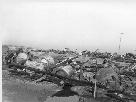 46 electric washing machines were destroyed in a Christmas night 1943 blaze in Block 202, Poston Unit II. Two mangles, 29 gas stoves, 8 electric refrigerators and an electric stove also were destroyed. The buildings served as warehouses for evacuee and personnel household goods. 12/25/43
|
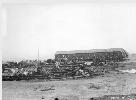 This photo shows the sweep of the fire which swept block 202, Poston No. II, on Christmas night, 1943, and the nearness of the buildings to the point where the fire was stopped. 12/25/43
Memorial |
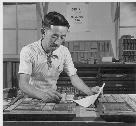 Saburo Tomita, foreman of the print shop, and the only Japanese-American to hold a card in the Pressman's Union. Saburo formerly worked for the Morrissey Brothers Printing Company in Los Angeles, and has had 22 years experience as a pressman. 5/5/43
|
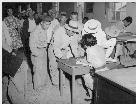 Residents of Colorado River Relocation Center for persons of Japanese ancestry requesting repatriation to Japan.
Memorial |
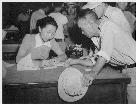 Residents of Colorado River Relocation Center for persons of Japanese ancestry requesting repatriation to Japan
|
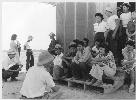 Norris James, WRA representative, gives instructions and assignments to the newspaper staff of evacuees of Japanese ancestry at this War Relocation Authority center. 6/4/42
Memorial |
 Mrs. Iwasaki tidies up her home at this War Relocation Authority center. Her family was the first family to be admitted to this center where evacuees are now spending the duration. 6/5/42
|
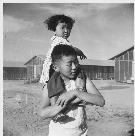 A little evacuee of Japanese ancestry gets a ride on her brother's shoulders at this War Relocation Authority center where they are spending the duration. 6/5/42
Memorial |
 Yukiyasu Uyeoka, soldier of the United States army, stands before the Poston Relocation Center's service flag as one of the 553 boys of Japanese ancestry whose parents now reside in the relocation center. Each week the number of stars increase on the Poston Service flag, as more boys volunteer and are accepted for service.
This was also called the Colorado River Relocation center. The Colorado river Indian Reservation Tribal Council opposed the construction of the camp since they did not want to participate in helping to perform an injustice of the type they had suffered, but they were overruled by the U.S. military.
Although it's called the Poston camp, there were actually three camps that made it up, called Poston I, Poston II and Poston III. The camp began operation on May 8, 1942. The maximum population reached was over 17,000. A far amount of the buildings from Poston I still exist; little is left from Poston II and little of Poston III.
The government report "Riots, Strikes and Disturbances in Japanese Relocation Centers (1943) comments on some of the problems at the Poston camp:
On Sept. 10, 1942, someone from the JACL was attacked by five assailants. On Sept. 12, 1942, someone was attacked by six or seven men. On Oct. 17, 1942, someone was attacked by three men; he had "occurred the ill will of a number of persons at Poston by virtue of his known desire to enlist in the United States Army and serve in the Japanese Language School at Fort Savage, Minnesota."
On Oct. 18,1942, a group of men broke into someone's room and beat him up. The guy had made remarks that he was working for the government. On Nov. 1, 1942, a man, his wife and son were attacked by five men. The guy was a member of the American Legion and had served in the U.S. military in the last war. On Nov. 14, 1942, anywhere from five to fifteen men entered a barracks and attacked a guy with a piece of pipe. It's the same guy who was beaten on Sept. 12.
On Nov. 18, 1942, there was a general strike starting around noon over the issue of getting some prisoners released. Some of those who went on strike said they did so out of fear of being attacked by those supporting the strike if they didn't join them. A mob of about 1000 people gathered in front of the camp jail and played martial music on the public address system. During the afternoon an official of the camp in charge of transportation was threatened and gasoline tanks of several white employees automobiles were drained. The report says "By night the Japanese had complete control of the camp except for the small portion where white citizens resided."
From the Final Report: Japanese Evacuation from the West Coast, 1942, dated June 5, 1963, a description of the area: "The Colorado River Relocation Center is situated on the lands of the United States Indian Service, being part of the Colorado River Indian Reservation at Poston, Arizona. It is seventeen miles south of the town of Parker, the railhead for the Center. The tract consists of 71,600 acres of land. Several types of soil are found in this area. Some is first class soil and highly suited to irrigation while some is fourth class and so highly impregnated with salts and alkali that cultivation would be difficult. Several irrigation canals traverse the area bringing water from the Colorado River which bounds it for a distance of about twenty-two miles on the west."
One positive article
For some reason this was the only positive article I found on the camp; the rest were quite negative.
 Syracuse Herald Journal, Oct. 23, 1942 |
Rebellion
Then serious trouble arose.
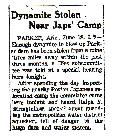 Reno Evening Gazette, Nov. 23, 1942 |
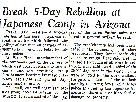 Wisconsin Radio Daily Tribune, Nov. 23, 1942 |
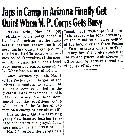 The Helena Independent, Nov. 24, 1942 |
And how shall I hate thee? Let me count the ways
Various articles came up with various ways for people to dislike the internees at Poston.
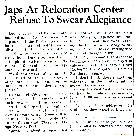 The Sheboygan Press, June 9, 1943 |
They don't say the Pledge of Allegiance.
 The News, June 10, 1943 |
They complain about getting $19 for a full month of work.
 The Oelwein Daily Register, June 11, 1943 |
They put white people under siege.
 The Zanesville Signal, June 11, 1943 |
Some of them look for U.S. defeat and have the audacity to stash food.
 The Nebraska State Journal, June 11, 1943 |
The blankety blank social workers wanted to make the internees "comfortable."
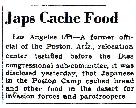 The Troy Record, June 11, 1943 |
They were stashing food for Japanese paratroopers and invaders (who, supposedly, would have skipped California to invade Arizona first.)
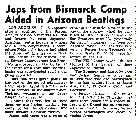 The Bismarck tribune, June 12, 1943 |
They beat up lawyers.
 The Portsmouth Herald, June 12, 1943 |
They went on strike.
 Syracuse Herald Journal, June 13, 1943 |
They're a danger to the dams.
 The Nebraska State Journal, June 13, 1943 |
They wrecked a train. Maybe.
 Nevada State Journal, June 19, 1943 |
They might have stolen some dynamite. Look out! They're going after the dam!
 The Sheboygan Press, June 28, 1943 |
In light of the other complaints, the fact that the children are being taught "American ways" is almost laughable.
 Edwardsville Intelligencer, July 8, 1943 |
But once in a great while the truth comes out. The "stored food" was a "half-eaten cheese sandwich." The dynamite referred a couple articles above this was, indeed, stolen. Three years earlier.
Although there have been many books written about the Japanese-American internment, only some of them even mention the newsletters produced at the camps and, at most, they generally will have only one or two pages from one of the issues.
This is leaving out one of the most historically interesting and important aspects of the internment. The newsletters that were produced give the day-to-day news of interest to the community of those who were interned. I am sure that there were restraints on what the newsletters were allowed to print, but they still tend to contain a wealth of interesting material.
I ran across one particularly valuable source, Densho. They have a vast number of the newsletters. I found a few elsewhere.
There are a large number of newsletters from Poston, so it will take quite a while to review them.
Volume 1, #1-5
Volume 1, #6-10
Volume 1, #11-15
Volume 1, #16-20
Volume 1, #21-25
Volume 2, #1-5
Volume 2, #6-10
Volume 2, #11-15
Volume 2, #16-20
Volume 2, #21-25
Volume 2, #26-30
Volume 2, #31-35
Volume 3, #1-5
Volume 3, #6-10
Volume 3, #11-15
Volume 3, #16-20
Volume 3, #21-25
Volume 3, #26-30
Volume 4, #1-5
Volume 4, #6-10
Volume 4, #11-15
Volume 4, #16-20
Volume 4, #21-25
Volume 4, #26-30
Volume 4, #31-35
Volume 5, #1-5
Volume 5, #6-10
Volume 5, #11-17
Volume 6, #18-20
Volume 6, #21-25
Volume 6, #26-30
Volume 7, #1-5
Volume 7, #6-10
Volume 7, #11-15
Volume 7, #16-20
Volume 8, #1-5
Volume 8, #6-10
Volume 8, #11-20
Volume 9, #1-5
Volume 9, #6-10
Volume 9, #11-15
Volume 9, #16-21
Volume 10, #1-5
Volume 10, #6-10
Volume 10, #11-15
Volume 10, #16-20
Volume 10, #21-25
Volume 10, #26-32
Volume 11, #1-10
Volume 11, #11-15
Volume 11, #16-20
Volume 11, #21-25
Volume 11, #26-30
Volume 12, #1-5
Volume 12, #6-10
Volume 12, #11-15
Volume 12, #16-20
Volume 12, #21-25
Volume 12, #26-30
Volume 13, #1-5
Volume 13, #6-10
Volume 13, #11-15
Volume 13, #16-20
Volume 13, #21-25
Volume 13, #26-30
Volume 14, #1-5
Volume 14, #6-10
Volume 14, #11-15
Volume 14, #16-20
Volume 14, #21-25
Volume 14, #26-30
Volume 15, #1-5
Volume 15, #6-10
Volume 15, #11-15
Volume 15, #16-20
Volume 15, #21-25
Volume 15, #26-30
Volume 16, #1-5
Volume 16, #6-10
Volume 16, #11-15
Volume 16, #16-20
Volume 16, #21-25
Volume 16, #26-30
Volume 17, #1-5
Volume 17, #6-10
Volume 17, #11-15
Volume 17, #16-20
Volume 17, #21-25
Volume 17, #26-30
Volume 18, #1-5
Volume 18, #6-10
Volume 18, #11-15
Volume 18, #16-20
Volume 18, #21-25
Volume 18, #26-30
Volume 19, #1-5
Volume 19, #6-10
Volume 19, #11-15
Volume 19, #16-20
Volume 19, #21-25
Volume 19, #26-30
Volume 20, #1-5
Volume 20, #6-10
Volume 20, #11-15
Volume 20, #16-20
Volume 20, #21-25
Volume 20, #26-30
Volume 21, #1-5
Volume 21, #6-10
Volume 21, #11-15
Volume 21, #16-20
Volume 21, #21-25
Volume 21, #26-30
Volume 22, #1-5
Volume 22, #6-10
Volume 22, #11-15
Volume 22, #16-20
Volume 22, #21-25
Volume 22, #26-30
Volume 23, #1-5
Volume 23, #6-10
Volume 23, #11-15
Volume 23, #16-20
Volume 23, #21-25
Volume 23, #26-30
Volume 24, #1-5
Volume 24, #6-10
Volume 24, #11-15
Volume 24, #16-21
Poston Chronicle Red Cross News
Poston Issei Official Bulletin
Poston Christian Church
Poston Chronicle, March 20, 1943
Poston Chronicle, June 9, 1943
References to the paper
Book on Poston
The Japanese Concentration Camp at Poston, Arizona: City in the Sun
You Tube Videos
Return to an Internment Camp
Touring Poston
Main Index
Japan main page
Japanese-American Internment Camps index page
Japan and World War II index page
|